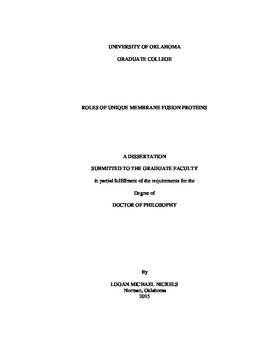| dc.description.abstract | One of the primary mechanisms of antibiotic resistance in bacteria stems from the expression of multicomponent efflux transporters, located in the membranes of both Gram-positive and Gram-negative bacteria. Although these transporters are divided into different families, many are dependent on membrane fusion proteins (MFPs). MFPs are thought to provide a functional linkage between the inner and outer membrane components of the complex in Gram-negative bacteria. However, these proteins have also been found in Gram-positive organisms, indicating a role beyond that of simply providing a link between transporter components. MFPs have since been shown to have diverse functions such as transporter stimulation and recruitment of outer membrane components. The extent to which MFPs participate in the transport reaction is still unclear. Also, the manner through which MFPs associate with their cognate inner membrane transporters (IMFs) and outer membrane channels (OMFs) is undefined. Furthermore, the details of MFP oligomerization and interaction with transporter components are unknown, leaving the picture of MFP-dependent transport incomplete.
This dissertation focuses on two unique MFP-dependent transporters. The first, TriABC-OpmH from Pseudomonas aeruginosa, is a paired-MFP transporter. TriABC relies on the two MFPs TriA and TriB in order for the resistance-nodulation division (RND) type transporter TriC to function with OpmH, an OMF. We constructed a functional, fused protein comprised of TriA and TriB. We also created deletion and point mutants of TriA and TriB, and analyzed the function and assembly of these mutants. Our functional genetic and biochemical studies demonstrate that the functional unit of the MFP is a dimer, and that TriA and TriB occupy different binding sites on both the TriC transporter and OMF. These results suggest that TriA and TriB have non-equivalent roles in the transport process, and that one protomer in the MFP dimer may be responsible for interactions with the OMF such as recruitment and substrate export, and the other interacts primarily with the IMF and is responsible for functions such as transporter stimulation. We propose that these findings also apply to transporters utilizing a single MFP, which oligomerize to form homodimers, rather than heterodimers.
The second MFP-dependent transporter discussed is the four-component YknWXYZ from the Gram-positive bacterium Bacillus subtilis. Here, the MFP YknX functions in tandem with the ABC-type transporter YknYZ and a protein of unknown function, YknW. Gram-positive bacteria have no outer membrane, making the presence of an MFP puzzling. To determine the function of an MFP in a Gram-positive cell envelope, we created chimeric fusion proteins between YknYZ and the homologous E. coli transporter MacB, and we attempted to analyze the stimulatory activities of YknX. We also purified different components of the YknWXYZ transporter to determine ATPase activity of the complex. We conclude that YknWXYZ is a unique, four-component transporter that warrants further investigation into the functions of MFPs in Gram-positive bacteria. | en_US |
